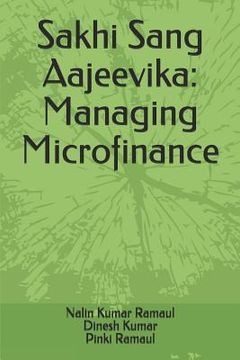Synopsis "Sakhi Sang Aajeevika: Managing Microfinance (in English)"
The book "Sakhi Sang Aajeevika: Managing Microfinance" is based on the research study sponsored by the Indian Council of Social Science Research (ICSSR), Ministry of Human Resource Development, Government of India, New Delhi, entitled "Impact of Women Self Help Groups (WSHG) formed under Swarnajayanti Gram Swarojgar Yojana (SGSY) In Himachal Pradesh". The analysis of the role of women self-help groups and micro-finance in women empowerment is important for devising appropriate policy interventions for women empowerment.Swarnajayanti Gram Swarojgar Yojana (SGSY) was a major scheme to bring the assisted rural poor families (swarojgaris) above the poverty line by assisting them to take up income generating economic activities through a mix of bank credit and government subsidy. The Ministry of Rural Development, Government of India has restructured the Swarnajayanti Gram Swarojgar Yojana (SGSY) as National Rural Livelihood Mission (NRLM), subsequently renamed as "Aajeevika".The book attempts an evaluation of the scheme in the Himalayan hill state of Himachal Pradesh on the basis of primary survey conducted during the research study in three districts - Kangra selected as the best performing district, Sirmaur as the poor performing district and Kinnaur as a tribal district.The total sample consisted of 270 women - 180 SGSY Women Self-Help Group (WSHG) members and 60 non-SHG members and 30 ex-members. Besides, 90 spouses of WSHG members were also surveyed. Thus, the total sample consisted of 360 survey respondents.The book builds on the growing body of research on the topic, blends academic and practitioner perspective and experiences, and encourages further exploration and dialogue on the subject. The research has important implications for bank managers, women micro-entrepreneurs and policy makers. There is a view that the microfinance can, at minimum, serve as a quick way to deliver finance in the interim; the idea is to then graduate microfinance clients to formal finance institutions where they can access standard 'individual' loans, possibly on a fully commercial basis. The notion of graduation should be built explicitly into the design of the scheme. The services and products need to be designed appropriately for small clients. Over the longer term, therefore, efforts to promote microfinance should go hand-in-hand with efforts to make the formal sector better at "banking the poor", and the government can play a critical role in this. The SHG movement must aim for involving every woman in rural India and link her to the micro credit and micro enterprise campaigns under SGSY/NRLM scheme.SHGs faced the problem of inadequate loan amount. The loan amounts given to the members of SHGs under SGSY/NRLM are very low. The inability of the small loans to lift people out of poverty has been a key drawback. Enterprise activities require higher outlays that could generate a poverty-alleviating income. Loan amount should be increased to the extent that they can take up an income generating activity sustainably.With the demonetisation and promotion of cashless transactions, the use of technology should be incorporated in the microfinance scheme also. Moreover, the SHGs can also be employed as business correspondents (BCs) and business facilitators (BFs) by the banks to accelerate financial inclusion and to facilitate micro-finance operations in remote areas.Our study tends to concur with other literature on the topic, which suggests that the government policies have been sub-optimal. Rather, the government policies need to be designed and implemented with care through participative development process and in a manner that will ensure that their positive impact will considerably exceed the costs and limit any potential negative side-effect. SHG movement should be recognised a people's movement and the role of government should be only to facilitate and create a supportive environment, rather than manage the movement directly.

